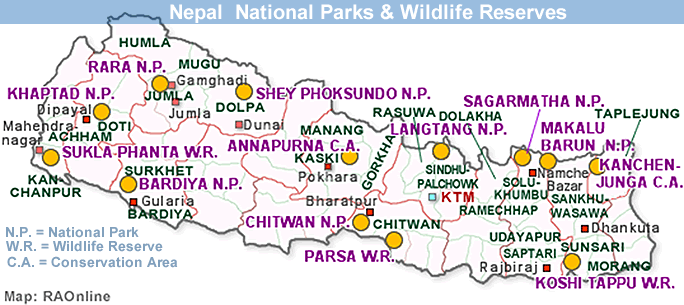 |
2005 |
|
 |
|
April
2005 Nepal's one-horned rhino population declines |
The
number of endangered one-horned rhinoceros in Nepal has declined in recent
years, due mainly to poaching, wildlife authorities say.
The
latest count of the population has shown that rhino numbers have dropped
to fewer than 400 from nearly 600 animals in three parks in 2000. Poaching
has been blamed largely on inadequate security caused by the long-running
Maoist insurgency.
Nepal
is home to a quarter of South Asia's rhino population. In the last official
count of the Nepal's one-horned rhinos, the authorities had claimed success
in the conservation of what is called the world's most endangered species.
The
2000 count showed that there were more than 500 rhinos in the country's
largest national park, Chitwan, and about 100 in two other smaller parks
- a 25% rise in the population over previous years. Five years later, the
rhino population had dropped by nearly a quarter, authorities said.
Trading
in the horn of the rhino is internationally banned, but experts say that
poachers are encouraged by the big profit margin. The government was forced
to cut down the number of security posts established to counter the poachers
in Chitwan national park due to fears of attack by the rebels.
|
March
2005 WWF helps orphan rhinos in Nepal |
WWF
Nepal is providing support to the country's largest national park by constructing
an enclosure to raise two orphaned rhinos.
The
two greater one-horned rhinos (Rhinoceros unicornis) include a female who
was rescued four years ago after its mother was killed by a tiger, and
a male who was rescued after being washed away and separated from its mother
about eight years ago. The enclosure is being built, with support from
WWF's Terai Arc Landscape (TAL) Programme and the Bill Jordan Foundation-UK,
in a natural setting at Kashara near the headquarters of the Royal Chitwan
National Park in order to protect the rhinos from futher tiger attacks.
In
the absence of an enclosure, a 17-month old rhino raised in the park was
recently killed by a tiger on 21 January 2005. "The park's scouts have
lately intensified the monitoring of the rhinos after they started foraging
in nearby fields," said Dr Chandra P Gurung, WWF Nepal's Country Representative.
"Despite the regular monitoring, one rhino succumbed to injuries sustained
in the tiger attack."
Mortality
of wild animals due to natural calamities and poaching has resulted in
increased numbers of orphans within the country's protected areas. These
orphaned animals are more vulnerable than those in the wild. Behavioral
changes are apparent among human-reared orphan animals, which reduce the
chances of their adaptability and survival in the natural habitat. However,
organisations, like WWF, are doing everything they can to make sure the
animals return to the wild.
"The
two orphan rhinos will be released in their natural habitat after they
become sub-adults," said Gurung. Two sub-adult rhinos raised at the Chitwan
National Park have already been translocated to the Royal Bardia National
Park.
WWF
Nepal has been providing support for the translocation of rhinos to establish
new viable populations in other protected areas of the country. The objective
of rhino translocation is to ensure the long-term survival of the endangered
species.
In
the late 1960s there were less than 100 rhinos left in Nepal. Thanks to
conservation projects developed by the King Mahendra Trust for Nature Conservation,
His Majesty's Government of Nepal's Department of National Parks and Wildlife
Conservation, the Biodiversity Conservation Network, and WWF, Nepal is
now home to over 600 rhinos, with Chitwan National Park having the second-largest
population in the world.
WWF
Global Species Programme
|
January
2005 Koshi Tappu Bird Festival
|
The
fifth Koshi Tappu bird festival will be organized at the Koshi Tappu Wildlife
Reserve, the largest watershed area of Nepal, from February 1 2005. The
festival is being organised on the occasion of the World Watershed Day
on the initiation of Nepal Tourism Board, Department of National Park and
Wildlife Reserve, Wildlife Preservation Office, World Wildlife Fund, World
Conservation Association and the local government and non-government agencies.
The festival would contribute to promoting Nepal as an eco-tourism destination.
Koshi Tappu can be a premier destination for eco-tourism especially in
the study of birds. There are 475 species of birds, both indigenous and
migratory, some of them rare ones. The festival is being organised for
the last five years. Birds migrate to Koshi Tappu from as far as Siberia,
Mangolia, Tibet and India and other Asian countries in winter for breeding
and other purpose.
An
ornithologist said that every year about 165 species of birds migrate to
the area at different times of the year - 90 species of them come to Koshi
Tappu during the winter. There are about 115 species aquatic birds indigenous
to Nepal. The area has 19 species of birds, which are considered rare or
endangered.
|
Links
|
 |
 |
 |
External
link |
 |
 |
Nature
and Natural Resources
ARKive |
|
 |
| 



